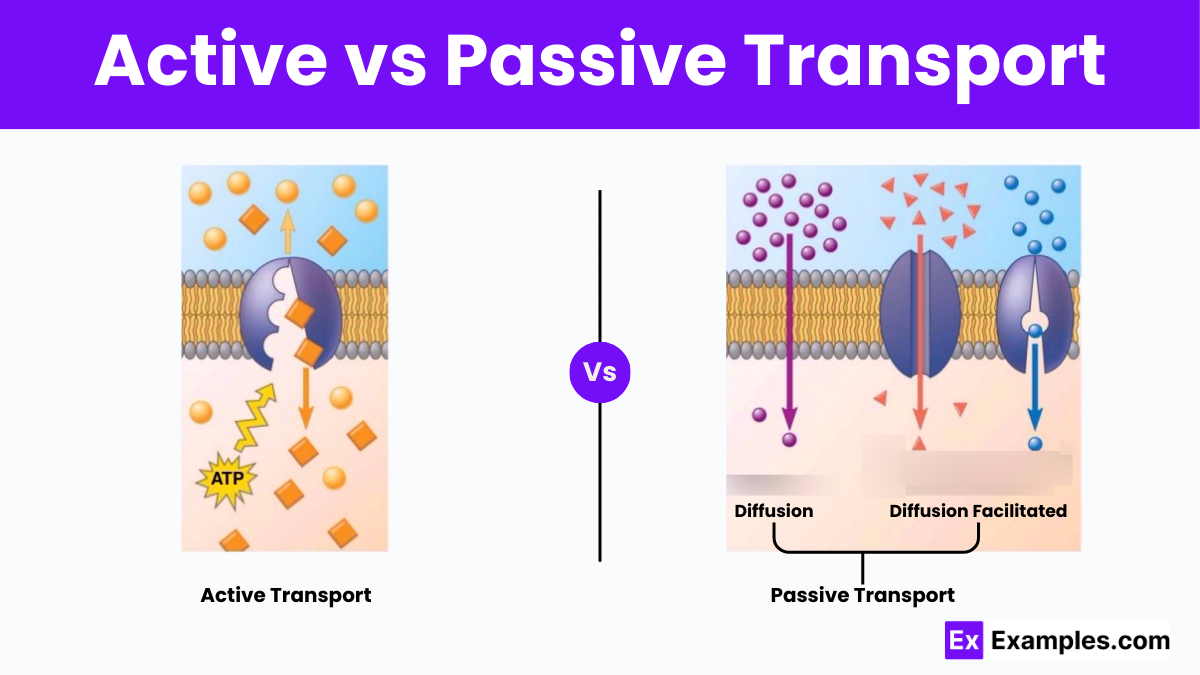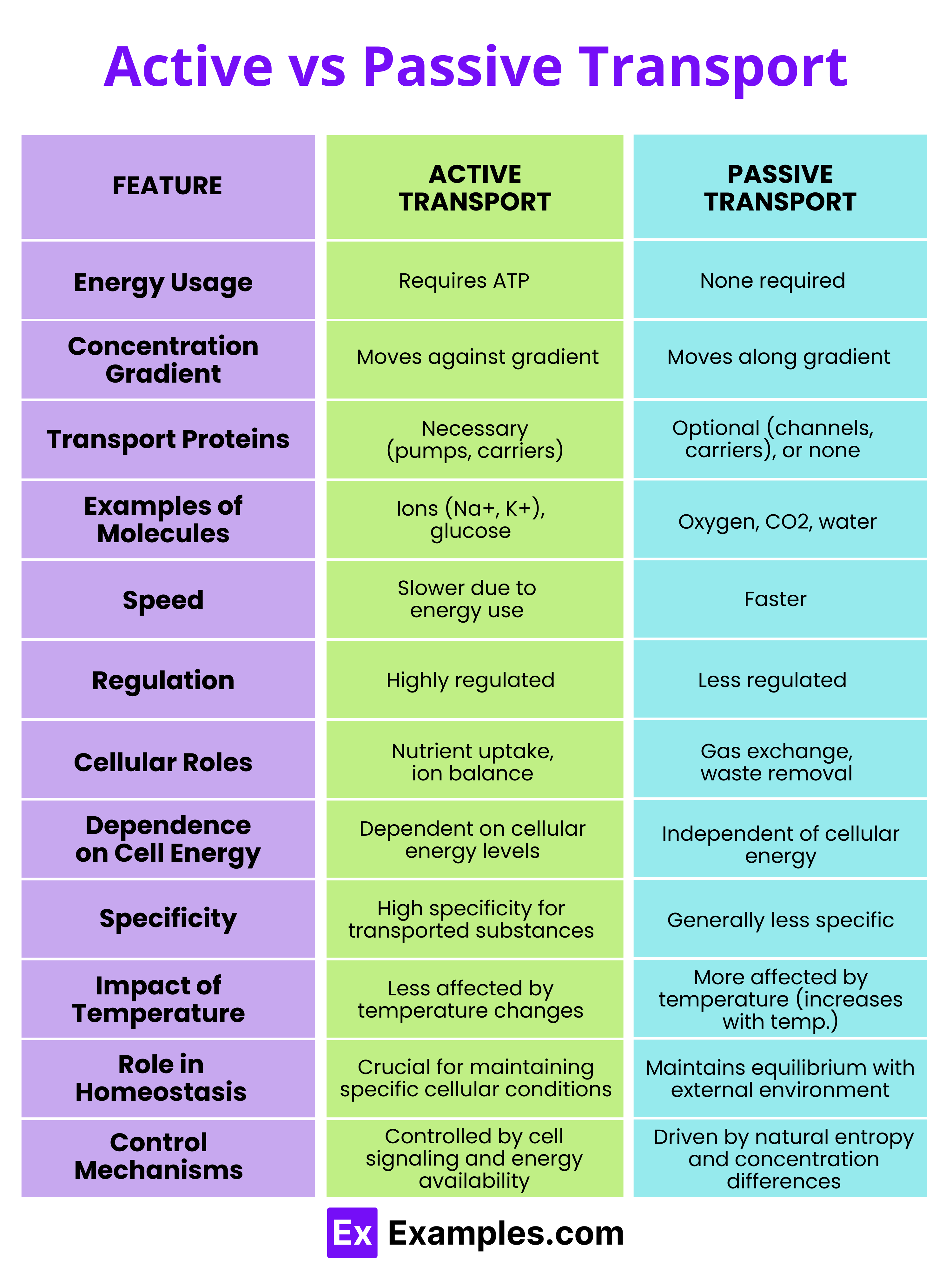Which of the following is a type of passive transport?
Endocytosis
Exocytosis
Exocytosis
Sodium-potassium pump


Active and passive transport mechanisms stand out as essential functions that support the life of cells. Both processes are integral to maintaining cellular health by managing the influx of nutrients, oxygen, and water, as well as the efflux of waste products. While they share a common goal of sustaining cell vitality, the methods by which they transport molecules across the cell membrane are distinctly different.
Active transport is the mechanism by which cells move molecules across the cell membrane from an area of lower concentration to one of higher concentration, against the concentration gradient. This process requires the expenditure of energy, typically derived from ATP (adenosine triphosphate), and often involves the assistance of specific enzymes and transport proteins. Active transport is crucial for maintaining concentration gradients of ions and other substances, which are vital for various cellular functions such as nerve impulse transmission and kidney function.
Passive transport, on the other hand, refers to the movement of molecules across the cell membrane along the concentration gradient, from an area of higher concentration to one of lower concentration, without the use of cellular energy. This process can occur via simple diffusion, facilitated diffusion through a membrane protein, or osmosis. Passive transport is key in processes like gas exchange in lungs and nutrient absorption in intestines where molecules move according to natural kinetic energy.

| Aspect | Active Transport | Passive Transport |
|---|---|---|
| Energy Requirement | Requires cellular energy (ATP) to move substances against their concentration gradient. | Does not require cellular energy, utilizes the kinetic energy of molecules moving down their concentration gradient. |
| Direction of Movement | Moves substances from a region of lower concentration to a region of higher concentration. | Moves substances from a region of higher concentration to a region of lower concentration. |
| Substances Transported | Transports proteins, large cells, complex sugars, and ions that are typically large or insoluble. | Facilitates the movement of soluble substances like oxygen, water, carbon dioxide, lipids, and sex hormones. |
| Cellular Role | Involves the active movement of molecules, crucial for functions like nutrient intake and waste removal. | Maintains cellular equilibrium by balancing concentrations of substances on both sides of the cell membrane. |
| Nature of Process | Dynamic and biochemical, involving substantial changes in cell membrane structure and function. | A more passive, physical process based on diffusion principles without energy use. |
| Selectivity | Highly selective, using specific carrier proteins tailored for particular substances. | Partly non-selective, permitting a range of molecules to pass based primarily on size and solubility. |
| Speed of Transport | Typically rapid, adapting quickly to the metabolic demands of the cell. | Comparatively slower, with the rate dependent on the concentration gradient and permeability of the cell membrane. |
| Directionality | Unidirectional, often moving substances in one predetermined direction. | Bidirectional, allowing for movement in either direction based on concentration differences. |
| Temperature Sensitivity | Transport rate can be influenced by temperature, which may affect the energy status of the cell. | Generally not affected by temperature changes, except in cases that affect the membrane’s fluidity. |
| Carrier Proteins Required | Yes, uses carrier proteins and pumps to facilitate the transport of specific molecules. | No, except in facilitated diffusion where specific carrier proteins assist in transporting molecules. |
| Oxygen Dependency | May be affected by oxygen levels as they impact cellular energy production. | Oxygen levels do not typically impact passive transport mechanisms like diffusion. |
| Inhibition Factors | Susceptible to metabolic inhibitors that can impair energy production and carrier protein function. | Not affected by metabolic inhibitors since it does not rely on cellular energy pathways. |
| Examples | Includes the sodium-potassium pump, exocytosis, and endocytosis. | Includes osmosis, simple diffusion, and facilitated diffusion. |
Passive transport moves substances along a concentration gradient without energy, while active transport requires energy to move substances against a gradient.
Active transport example: Sodium-potassium pump. Passive transport example: Osmosis.
Three types of active transport are the sodium-potassium pump, endocytosis, and exocytosis.
Three main types of passive transport are osmosis, diffusion, and facilitated diffusion.
Text prompt
Add Tone
10 Examples of Public speaking
20 Examples of Gas lighting
Which of the following is a type of passive transport?
Endocytosis
Exocytosis
Exocytosis
Sodium-potassium pump
Which process requires energy to move molecules across a cell membrane?
Diffusion
Facilitated diffusion
Active transport
Osmosis
Which of the following best describes passive transport?
Movement against the concentration gradient
Requires energy from ATP
Movement with the concentration gradient
Involves transport proteins only
What is an example of active transport?
Osmosis
Simple diffusion
Sodium-potassium pump
Facilitated diffusion
In passive transport, molecules move:
From low to high concentration
From high to low concentration
Against their concentration gradient
Only with the help of ATP
Which of the following statements is true about active transport?
It does not require energy.
It moves substances down their concentration gradient.
It requires energy in the form of ATP.
It only occurs in prokaryotic cells.
Facilitated diffusion is a type of:
Active transport
Passive transport
Bulk transport
Endocytosis
Which molecule is primarily involved in active transport processes?
Glucose
ATP
Water
Oxygen
What characterizes facilitated diffusion?
Requires energy from ATP
Moves molecules against their concentration gradient
Uses transport proteins
Only occurs in plant cells
Which process moves large particles into the cell?
Diffusion
Osmosis
Endocytosis
Exocytosis
Before you leave, take our quick quiz to enhance your learning!

